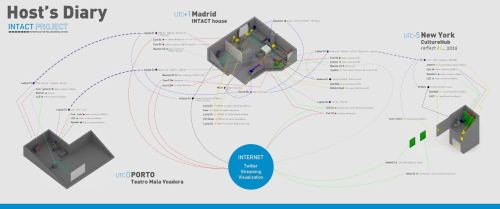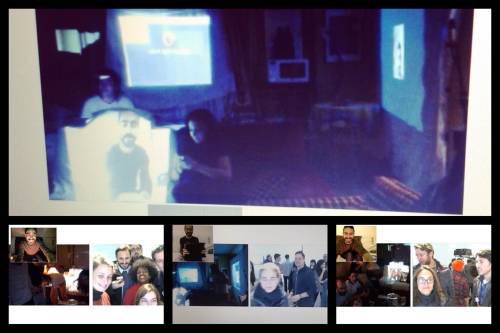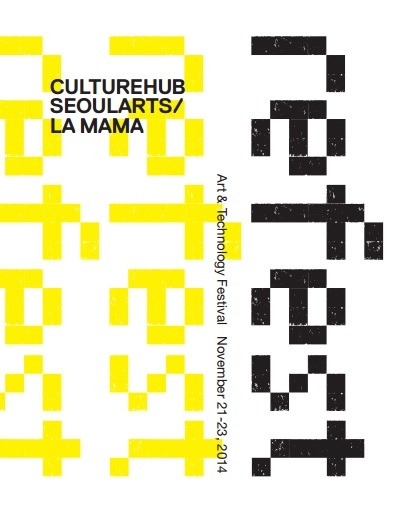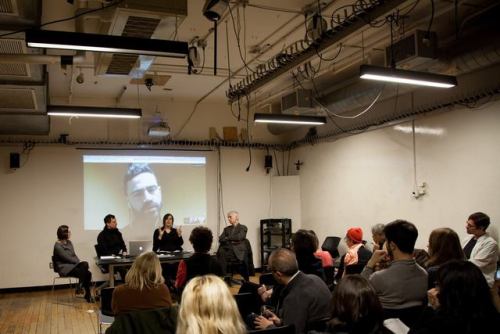#culturehub
#collaborations
HOST’S DIARY - telepresence durational installation at CultureHub’s REFEST'14 Art&Technology Festival (21,22,23 November 2014)
@dannyblueboy@ARTEKLAB@Notengopajaros@saramalinarich The Host Diary pic.twitter.com/hyjdiiRQGx
— rachael runner (@Rachael_Runner)November 22, 2014
Visit Host’s Diary webpage to get a full overview of the documentation processed and archived via twitter of all the interactions made during the connection.
Amazing moments at #Refest@culturehubnyc#Host’s diary by @intact_01#telepresence social power! pic.twitter.com/qsoEYCwyY9
— ARTEKLAB (@ARTEKLAB)November 25, 2014
All information about the piece: www.intact01.net/host-diary/
CONTEXT: Refest. Culturehub, NY.
EXHIBIT: La MaMa Gallery
DEVELOPMENT IN EUROPE:
- House located in Velázquez Street (Spain).
- A room inside Mala Voadora’s Theater (Porto, Portugal)
Starting Time: 01AM (Madrid) / 07PM (La Mama Gallery, NY) / 00AM (Mala Voadora, Porto)
Artists:Intact Ciberculture|Culturehub
Post link
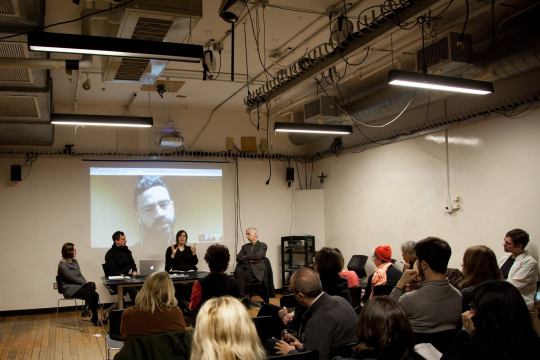
“Now, more than ever, we need to get together to explore ways in which the live media can be used to foster action, creativity, and inclusivity!” - REFEST 2.0 / Presented by ITP, CultureHub, and WITNESS at ITP/NYU - 721 Broadway 4th Floor
The State of Telematic Art in 2017 - A Panel Discussion (Billy Clark, Michael Dessen, Daniel Pinheiro, Jesse Ricke, Robert Rowe, Kate Sicchio, & Sarah Weaver)
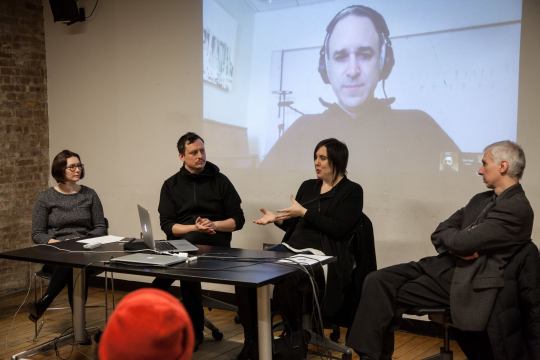
Check out photos of Refest 2.0 here!
Some thoughts on The State of Telematic Art:
From the early experiments on satellite connections to allow the bringing together of distant remote locations into one same (shared) space until nowadays seamless use of online tools that almost invisibly bring together users from any location into the same room, Telematic Art has been exploring the way technology – and more specifically networked environments – shapes human interaction.
The possibility of dissipating time and distance in projects from artists like Kit Galloway, Paul Sermon or in the thoughts of Roy Ascott has been a major concern towards the development of ‘structures’ that often reflect upon the human impossibility of ubiquity.
In projects like LAND PROJECT or, within that one, the more recent, in collaboration with Annie Abrahams, Distant Feeling(s) the main goal is to deconstruct the sense of co-presence in the same time and space and traduce it / materialize it into actions that are (possible) models of re-thinking our agency in a networked society and within the digital sphere.
Either by experimenting ‘moving’ together with someone that is not in the same space as you, but that becomes present through mediation or trying to perceive the presence of ‘others’ in the network by creating a moment of silence and stillness where we’re left alone in front of our computers but as a group, the art object becomes complete in the intersection space; often the output (the format in which the result is shown) – the same surface used for the process of mediation to happen.
Although networked practices find at its core, with the developments made over the last decade on having the tools more accessible to the practitioners, the possibility of building connections between artistic communities and bringing them together in a more sustainable way providing a medium that beyond allowing connection facilitate collaboration, these practices deal with characteristics of the environment in which they happen and elaborate on ways to approach them and shape the methologies of artistic production. The perception of synchronicity in projects like the one’s of Sarah Weaver is one of the many aspects included in the way our body and brain perceive this context which is a specific space for which a specific type of art is being developed.
Thinking about the space where Telematic Art happens is to re-think a space/place and developing tools that widen the potential of the practices related to it. Either it is by connecting human-to-human through the machines, input external live data that disrupts the ‘normal’ (organic) way of moving and/or behaving or, as an example, investigate latency as part of music composing where sounds travel across distant locations and how all of this is (also) a consequence of living in the digital age, transforms telematics into a process of thinking the world we live, acknowledging that we are not constricted to our own contexts but that we can (more easily) reach out and build significant discourses about possible futures – an extension of what we are now.
To be thinking and practicing Telematic Art was and it is about reformulating the present by overcoming (and troubleshooting) impossibilities allowing our perception about the world to change.
Youngblood reiterates the ethical responsibility of artists to utilize telecommunications in a socially constructive manner, but is skeptical of how early telematic artworks merely repeated what had become common commercial practices. “A communications revolution is not about technology; it’s about possible relations among people,” he observes, arguing that this revolution has the potential to invert extant social relations, transforming the centralized, hierarchical structure of geographically discrete nations into one of decentralized, but politically significant, communities defined by “consciousness, ideology and desire.” (…) the artistic use of telecommunications is “special” (i.e., art as opposed to nonart) only if the media are employed in a way that is not “done every day in business and industry,” and therefore “given, obvious, routine, … [and] politicized.”-‘Roy Ascott, Telematic Embrace - Visionary Theories of Art, Technology, and Consciousness’
“Now, more than ever, we need to get together to explore ways in which the live media can be used to foster action, creativity, and inclusivity!” - REFEST 2.0 / Presented by ITP, CultureHub, and WITNESS at ITP/NYU - 721 Broadway 4th Floor | March 5th, 2017
The State of Telematic Art in 2017
A Panel Discussion (Billy Clark, Michael Dessen, Daniel Pinheiro, Jesse Ricke, Robert Rowe, Kate Sicchio, & Sarah Weaver)
Check out photos of Refest 2.0 here!
Some thoughts on this here
Post link

